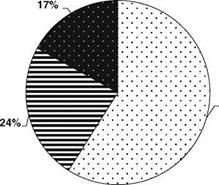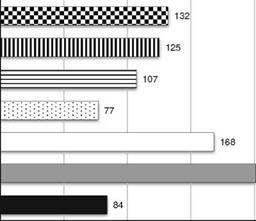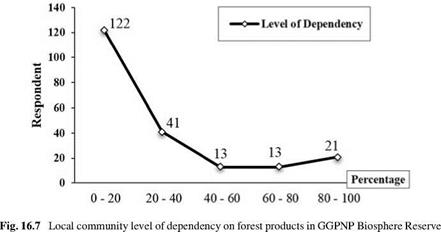Some information on demographics and household economics was collected from the local people using the questionnaire. In total, 210 respondents were selected from six villages in the transition zone of GGPNP. The data revealed that 361,002 people lived within the area (Mulcahy and Mc Carthy 2010).
Table 16.3 shows general information about the six villages in the study areas. Agriculture is the main sector of occupation for the local people; most of them were mainly employed as farming labor. In Tangsel Village, most of the respondents have double jobs. Besides working as farm laborers, they also worked in the tea plantation industry, which was located in the borderline between the park and the settlement area of the local people. The tea plantation itself was established in 1921, and recently the area has been developed into an agrotourism center equipped with some sport facilities. Table 16.3 also notes that Pasirhantap Village is the nearest village to the forest edge, but it is also the farthest village from the main road in contrast with Tangsel Village. The elevation of Tangsel village is relatively high, but the steepness of the slope is not great.
Figure 16.3a shows wealth status and number of family members in the study site. Wealth status was defined by considering the ownership of land and livestock in each household. The average land size owned by each family was less than 2 ha. Thirty-five percent of the respondents were classified as poor households, meaning that they did not have any land or livestock. In several villages, the local people used to own land, but they have sold it to urban people to earn money for several reasons, such as weddings and circumcision ceremonies. Consequently, they are
|
Table 16.3 General information of the six villages in the study site
|
 |
 |
b Number of family members
now getting used to working as farming laborers on their own previous land. Figure 16.3b shows the number of persons living in a one-unit house. In average, four or five persons occupied a one-unit house. Some households had a large number of family members because parents, adult siblings, relatives, and children lived together in one house.
Figure 16.4a describes the distance from the house to the forest edge, which is classified as (1) less than 1 km, (2) 1-2 km, and (3) more than 2 km from the forest edge. More than half of the respondents (59 %) lived close to the forest edge. The local people used footpaths to reach the forest edge, instead of roads. Some of the roads in the study site site from the main road to the village were not made of concrete or cement and almost half the roads had some potholes. Figure 16.4b shows the education level of the local community, which was very low. Most of the household leaders did not achieve elementary school or never went to school at all. Seventy-six percent of them could attain the basic education level, and only 7 % of them obtained their education at a level up to senior high school or higher.
Fig. 16.4 Distance to the forest edge (a) and education level (b) in the study area

![]()

 b Education level
b Education level
![]()
![]()

 76%
76%
One reason for the low level of education was the distance from the schools. For example, the distance from Lembur Pasir to the closest elementary school was around 8 km. The respondents were questioned about the type of forest products utilization and the estimation of quantities for their daily consumption. The local people used the forest products either for daily consumption or for trading. The price of forest products consumed in their daily life was estimated based on the price in the village or in the closest market. The community used seven forest products, including agriculture products, fuel wood, gum, bamboo, fruits, and flavorings.
Table 16.4 indicates that each village utilized different forest products. For example, Pasirbuncir and Cibeling villages in Bogor District utilized all the forest products; Gunungputri, Sarongge, Pasirhantap, and Tangsel villages only utilized
|
Table 16.4 Forest products utilization and total number of respondents in six villages
|
|
Fig. 16.5 Total respondents and forest product utilization perception |
several forest products such as agricultural activities, fruits, fuel wood, and bamboo. The other two villages, Cibeling and Pasirbuncir, concentrated on collecting gum and flavorings. Fuel wood was the common forest product used by a local community for daily purposes. People collected fuel wood from dead stands and dry branches. They never cut the living trees for fuel wood (Fig. 16.5). Another forest product, bamboo, was used for construction, such as for fences or stabling for livestock. Usually, people collected wild bamboo growing in the surrounding forest area. Gum was collected every day from pine (Pinus merkusii) trees and sold to the markets weekly. Gum and flavors were collected only for commercial purposes.
The questionnaires could also explain the local community perception of forest function. In the questionnaire, forest function was divided into seven categories, from which each respondent could select more than one category. The functions were selected by the respondents in accordance with their forest activities. The results in Fig. 16.6 show that around 201 respondents gave their opinion, saying that the GGPNP Biosphere Reserve had as its main function the water resource. Forest as an area for conservation was the second largest perception given by the
respondent

![]()
![]()
![]()
 250
250
respondents concerning the forest function. No more than 77 people perceived the forest as a resource for family income. The results also showed that 95 % of respondents agreed that the GGPNP functioned as a water resource. The third function of the biosphere reserve selected by the respondents was forest for recreation. Particularly during weekends, local people go to the park located in the eastern part of the biosphere reserve to enjoy the fresh air and mountain views. Generally, the local people in the transition zone of the park gave good perceptions on the forest functions simply, because they agreed and realized that the park should exist to maintain a clean water resource.
The forest products shared in contributing to the household total income. Household cash income was generated from agricultural activities, forest products, salary, pensions, and other sources. The household dependency level on forest products was measured from the ratio between income generated from forest products and total household income. To identify the level of dependency of the local people, the income generated from forest products was classified into five levels: less than 20 %, 20-40 %, 40-60 %, 60-80 %, and more than 80 % of total income. Table 16.5 summarizes analysis of the level of dependency of the local people on forest products. About 58 % of the respondents depended on forest products, with 0-20 % of their total monthly income obtained from these products. Only 10 % of the respondents were highly dependent on the forest with more than 80 % of their total monthly income from forest products. On average, the forest products contributed about 28 % of their total income. The social conditions of communities in the transition zone of park were similar, with agriculture as the main resource of income and 76 % of education obtained below junior high school. Seven forest products mainly collected by local people were agriculture, fuel wood, gum, bamboo, fruits, flavor, and other. Eighty percent of the local community used
|
Table 16.5 Household level of dependency on forest products (unit: respondents)
|
fuel wood for cooking. Fuel wood was one type of energy source as a substitution for kerosene and gas. Sometimes people combined use of fuel wood with that of kerosene or gas to reduce expenditure.
Agriculture was the second largest category of forest products used by the local people. They used to open forestland for agricultural activities, and therefore agriculture was considered to be the biggest threat to the biosphere reserve. The GGPNP Management Board has been trying to prevent the expansion of agriculture land by providing consultation programs to the local people. Another effort applied by the park was a lending agreement between the management board and the local people, by which the local people were able to use the forestland for their agricultural activities for a certain period. This plan did not occur in entire villages where people used the same type of forest products; it depended on the condition of each village. For example, people in most villages collect fuel wood as the main forest product, but in Gunungputri, fuel wood was the second most desirable product after agriculture products. The local people in Cibeling and Pasirbuncir mainly collected gum, because the forest edge surrounding those villages was covered by pine forest. They had started collecting gum 10 years ago when the state-owned forestry firm managed the pine forest. Starting in 2003, the management board has taken over the management of the pine forest.
The level of dependency on forest products in the transition zone of biosphere reserve was quite low. The result of statistical analysis (Fig. 16.7) shows that 58 % of respondents said that less than 20 % of the forest products contributed to the total household income. About 10 % of the respondents highly depended on forest products, which contributed about 80-100 % of their total income. Based on the field survey, households who used forestland for agricultural activities had a higher-level dependency compared to other households, because household income that is derived from agriculture depends on its location in forestland.
The level of dependency is low because surrounding the study site are several sources of occupation. For example, several industrial factories and restaurants are located, usually on the road, so that local people could work as laborers. On the other hand, the local community depends more on agriculture productivity than on forest products. The level of dependency on forest products among the local community in the GGPNP Biosphere Reserve is significantly determined by several factors. Multiple linear regression proved that from nine of independent variables
|
|
only five variables such as gender, household size, policy, off-forest income, and elevation are mainly responsible for determining the level of dependency. Results showed that the households with low off-forest income, large household size, and located in a remote area are more dependent on forest products compared to other households. Off-forest income shows strong significant negative correlation to the level of dependency. It is implied that if the farmer could create more income from non-forest products, the dependency on forest products tends to decrease. In fact, a household with a low off-forest income is categorized as a poor family. Income relates to education level. The education level of the local people in this biosphere reserve is low. If the education level is low, the opportunity for local people to get better jobs with a good salary is small. However, agriculture activity and collecting forest products does not require a high skill level and education.
Additionally, the men collect fewer forest products than do the women. In the study site, the man is the decision maker in a family and is responsible for the family income. Women usually stay at home and take care of all family members. In daily activity, women collect forest products such as fuel wood, vegetables, and flavorings for cooking. The men usually work as agricultural laborers or as company labor. During the field survey, female respondents answered the questions in more detail than did male respondents. The level of dependency is also related to household size. It can be understood that a household of large size depends more on forest products in their livelihood. A larger household requires more fuel wood for cooking and more additional income. Furthermore, the statistical results show that the Conservation Village Model (CVM) program is not yet successful in reducing the dependency of the local community on forest products. Households who received support through the program are still dependent on forest products. Even though the sign was not appropriate, it does not mean that this program has failed to improve family welfare. The program was launched in 2007 and the local community has not yet received the benefits of the program; additional time and refinement are required to implement the program.
Another reason is the fund recipient (household leader) might lack a sense of responsibility. This program has tried to support local people by giving livestock and seedlings, but according to the field survey, several respondents who received a goat or sheep sometime sold them to obtain cash money directly. Hence, they returned to collecting forest products as additional income afterward. This research also considers the effect of natural condition related to the level of dependency on forest products. Elevation and steepness of slope are two variables that represent natural conditions.
It is statistically proven that off-forest income and elevation of the household strongly affect household forest dependency. A house located in high elevation (upper areas) is usually in a remote area and is relatively far from the market. The dwellers try to fill their needs from agricultural activities by collecting forest products. They depend more on forest products compared to local people living in a house that is located at a lower elevation. The average degree of condition of steep roads to collect forest products are around 10 % to 20 % in degree of slope. Some respondents also go to the forest area to collect forest products even though the steepness of the road is 20 % or 30 %. Gender and policy are significant at the 5 % level and household size at the 10 % level. Simply, the household with low off-forest income, large family, and located in a remote area is more dependent on forest products.
There are two kinds of dependency on forest products in the local community in the GGPNP Biosphere Reserve: dependency on forest products as economic resources and dependency on intangible forest products as functions such as water supply, fresh water, and mountain views. Although economically the value of forest products is low, unwittingly local people depend highly on intangible forest products, such as water resources, fresh air, and tourism areas. The results of the questionnaire showed that 70 % of local people are using clean water that is sourced from the forest area directly. Ninety-five percent of the local community said that the biosphere reserve functions as a water resource and 62 % of them were enjoying the forest area for recreation.
16.2 Conclusion
Forestland and forest resources are important for the local community in the transition zone of GGPNP Biosphere Reserve. Forest income constituted an average of 28 % of the local community income. The level of dependency on forest products was influenced by several factors, such as gender, household size, policy, off-forest income, and household elevation. Based on the questionnaire results, the local community in the transition zone utilized the forest for collecting several forest products (fuel wood, bamboo, gum, fruits, flavor, etc.) and used forestland for agricultural activities. Forest products served not only as a primary livelihood source but also for additional income of the local people. The forest income was more important for poor families, especially those who were located in remote areas.
The local community realized that the forest area must exist to support their life. Although not the entire local community gets direct benefit from the forest by collecting forest products, some of the local community also depend very much on the indirect benefits from this biosphere reserve such as ground water, rivers, and clean air.
16.3 Recommendations
Another study should be conducted in the future in the other villages also located surrounding the GGPNP Biosphere Reserve to obtain a comprehensive picture of forest dependency in the area. In addition, more research focusing on the effect of environmental conditions related to the level of dependency is needed. The local government should initiate some programs introducing alternative income generation through skill development and training for the local people.
By these measures, the local people can generate economic activities without damaging forest resources. Additionally, the investment in infrastructures and markets, as well as the collaboration with all involved stockholders, can stimulate the generation of new economic opportunities that in turn can create economic diversity in the villages surrounding the park.
Acknowledgments This research was supported by the Global Environmental Leaders (GELs) Education Programme of Hiroshima University, Japan and the Ministry of Forestry, Indonesia.





